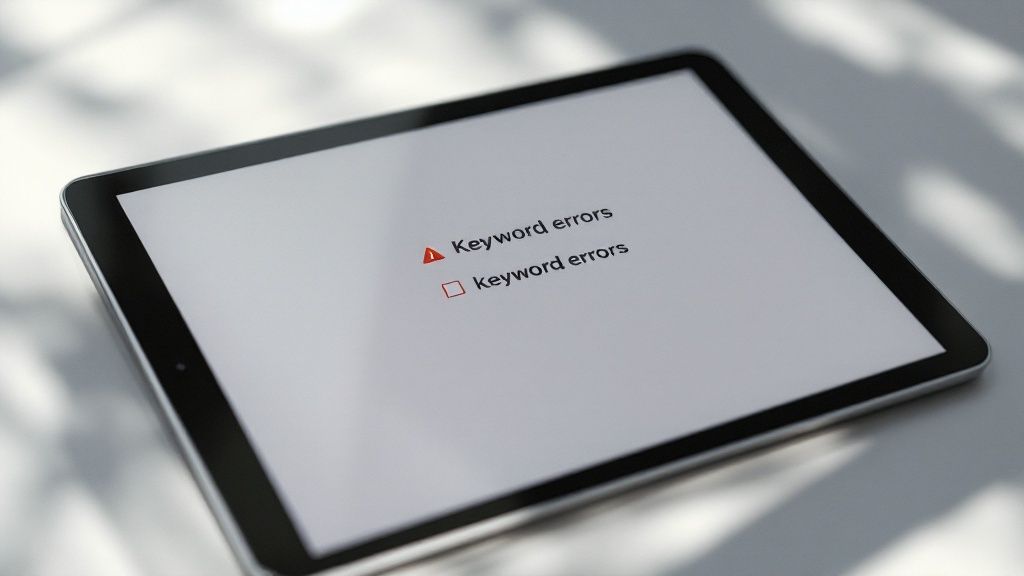
Meta Description: Stop chasing a magic number. Learn how many keywords to use for SEO by focusing on user intent, content type, and natural placement for higher rankings.
Are you constantly asking, "How many keywords should I use for SEO?" It’s a common challenge for marketers and creators, often leading to confusion between using too few keywords and risking a penalty for keyword stuffing. The truth is, the old rules of keyword density are dead, and relying on them can hurt your rankings more than help. This guide will shift your focus from arbitrary counts to a smarter, quality-first approach. We'll explore how to align your keyword strategy with user intent and content type, ensuring you connect with your audience and climb the search rankings.
But before we dive in, it helps to have a solid grasp of the basics. This comprehensive guide to SEO for beginners is a great place to start if you need to brush up on the essentials for ranking higher.
Quality Over Quantity: The New SEO Mantra
Let's get one thing straight: the old days of chasing a specific keyword count are long gone. The golden rule of modern SEO is refreshingly simple—focus on relevance, not repetition. It's far more effective to think of your content as a meaningful conversation with your audience, not a numbers game. For a digital agency, this means creating a blog post for a client that answers questions thoroughly, not just hitting a keyword target.

In this conversation, your primary keyword is the main topic. Then, a small, hand-picked group of secondary and related keywords act as the supporting details, adding the depth and context that make the discussion valuable.
From Keywords to Topical Clusters
Instead of a simple list, start thinking of your keywords as a cluster around a central theme. For example, if a content creator's primary keyword is "AI content creation," their article should naturally touch on related terms like:
- "AI text generators"
- "Using AI for social media posts"
- "Best AI image creation tools"
- "AI content repurposing"
By addressing these sub-topics, you build a far more authoritative piece. You're not just answering the user's first question—you're anticipating their next one. This is how you become a go-to resource in your niche and a core principle of any effective small business SEO strategy. If you want to dive deeper into building high-value content, check out our guides on content optimization.
Matching Your Keyword Strategy to Content Type
There’s no magic number for how many keywords a page should have. The truth is, different pages on your website have different jobs to do. For instance, a freelancer’s homepage needs to quickly communicate their core services, while a deep-dive blog post is designed to educate and cover a topic from every angle. It's only natural they'd target a different number and type of keywords. The real key is aligning your keyword strategy with the specific purpose and length of your content.

Recommended Keyword Targets by Content Type
So, how many keywords should you actually aim for? It all comes down to the page type, content length, and how competitive your topic is. A homepage, for example, typically only needs to focus on 3 to 5 core keywords, while a comprehensive, long-form article can naturally weave in 15 to 30 keywords. You can dig into more insights on how content length impacts keyword strategy on seoprofy.com. To make this even more practical, here’s a table you can use as a guide:
| Page Type | Primary Keywords | Secondary/LSI Keywords | Example Use Case (for a Marketer) |
|---|---|---|---|
| Homepage | 1-3 | 2-5 | Targeting "digital marketing agency" and "content strategy services." |
| Service Page | 2-4 | 5-10 | Focusing on "SEO content writing" and its benefits like "blog keyword research." |
| Short Blog Post | 1-2 | 4-8 | Answering a single question, like "how to write a meta description." |
| Long-Form Guide | 3-5 | 15-25+ | A comprehensive guide on "The Complete Guide to Social Media Automation." |
This is the bedrock of modern content marketing. Of course, building out these detailed guides takes time. To keep up, explore the best AI tools for content creation that can speed up your workflow.
How to Place Keywords Naturally for Maximum Impact
Forget the outdated metric of "keyword density." The modern approach is about placing keywords strategically and, most importantly, naturally. The goal is to signal relevance to search engines without making your content sound robotic. Your primary keyword needs to show up in the most important places on the page to make the biggest impact.

Prioritize High-Impact Locations
Some spots on your page carry more weight with Google than others. To get the most bang for your buck, make sure your primary keyword appears in these key locations:
- Title Tag: Your prime real estate. Get your main keyword in here, as close to the beginning as possible.
- Meta Description: While not a direct ranking factor, a compelling meta with your keyword can significantly increase clicks.
- H1 Heading: Your main on-page title, which must include your primary keyword.
- First 100 Words: Drop your main keyword in your opening paragraph to confirm the page's topic for readers and crawlers.
- Subheadings (H2s & H3s): Sprinkle your primary and secondary keywords into some subheadings to structure your content and reinforce relevance.
Nailing this structured approach is a huge part of effective SEO. You can sharpen your skills even more by checking out these essential SEO copywriting tips. The number one rule is always user experience; your placement should never make the text awkward.
👉 Try MediaWorkbench.ai for free – schedule your posts and generate AI content in one place!
Your Secret Weapon: Long-Tail Keywords
While everyone wants to rank for big, flashy keywords, the real magic often happens with long-tail keywords. These are longer, more specific phrases (usually three or more words) that people type into Google. While they have lower search volume individually, the traffic they bring is far more valuable because the user's intent is much clearer. For a startup selling project management software, ranking for "best project management tool for remote creative teams" is more valuable than just "project management tool."
Why Long-Tail Keywords Convert Better
People search using natural language and specific questions. Long-tail keywords perfectly match this behavior, making them essential for voice search as well. A single, well-written article can target a main topic while also scooping up traffic for dozens of related long-tail queries. For example, a post about "SEO tools" could also rank for:
- "best SEO tools for small business"
- "how to choose an SEO tool for content marketing"
- "free keyword research tools for beginners"
The numbers don't lie. A staggering 91.8% of all search queries are long-tail keywords. This proves that chasing a few popular terms is less effective than targeting a wide array of specific, intent-driven phrases. Even better, these specific searches have conversion rates 2.5 times higher than generic ones. You can find more stats from keyword.com on this topic.
Finding Your Keyword Sweet Spot
So, what's the verdict on how many keywords should i use for seo? The answer isn't a number—it’s a strategy. Success comes from knowing your audience, creating genuinely helpful content, and weaving in keywords naturally. Start with one primary keyword for each page as your North Star. Then, support it with a handful of closely related secondary and long-tail keywords to add context and depth. The key is to adapt this approach based on your content's goal and format. Forget about keyword quantity and shift your focus to quality and strategic relevance. That’s how you build an SEO foundation that drives real results.
This strategic mindset separates good SEO from great SEO. And having the right toolkit makes all the difference. To get a better handle on which platforms can help, check out our insights on top SEO tools.
Ready to take the guesswork out of your content process? MediaWorkbench.ai combines AI content generation, scheduling, and optimization in one platform. Stop wasting hours on manual tasks and start creating articles that rank.
👉 Discover how Media Workbench AI can accelerate your content creation today!

